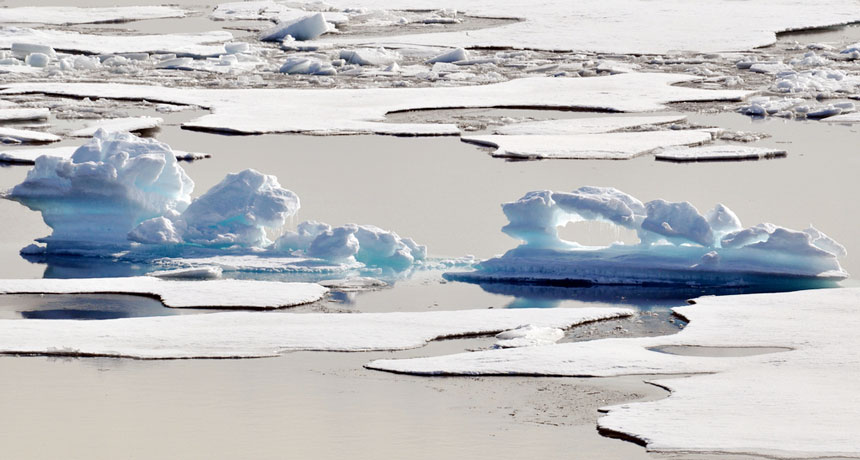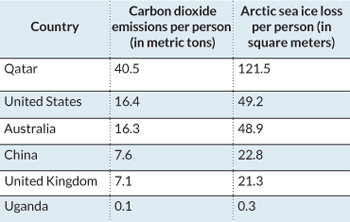Arctic Sea could be ice-free by 2050
Summer sea ice could soon be gone due to humanity’s large carbon dioxide output

Arctic sea ice could disappear completely in summer by 2050. That’s sooner than scientists had thought. The estimate is based on new calculations of how carbon dioxide contributes to ice melting.
PATRICK KELLEY/U.S. COAST GUARD
The average American’s carbon footprint shrinks Arctic sea ice. Not by a little. By a lot — about the area covered by 16 queen-size beds. And that happens each year.
A carbon footprint is the number of tons of carbon dioxide a person produces in their daily activities. The average American produces about 16 metric tons of carbon dioxide each year. Each metric ton of this CO₂ released into the atmosphere directly results in a 3-square-meter (32-square-foot) loss of sea ice cover at summer’s end. That’s similar to losing an area of ice just a bit smaller than a two-seat Smart car, scientists say. They reported their findings online November 3 in Science.
“For the first time now, it is possible to grasp how each one of us contributes to tangible consequences,” says Dirk Notz. He works as a climate scientist at the Max Planck Institute for Meteorology in Hamburg, Germany. He was an author of the new study.
How much CO₂ each person produces leads to a lot of melting ice. And there are some 7 billion people contributing. Altogether, humanity is responsible for the release of some 36 billion metric tons of CO₂ each year. With another trillion metric tons, the Arctic Ocean will have a completely iceless summer.
This might be the first time the summer Arctic has been ice-free in 125,000 years. And it could happen before 2050, Notz estimates. He did the work with Julienne Stroeve. She is a climate scientist in England at University College London. The estimate by these two contradicts many previous studies. Those other studies projected that summertime ice in the Arctic would stick around for far longer.

“Sea ice feels so substantial,” says Cecilia Bitz, especially when its strong enough to land an airplane on. But this new work, she notes, “makes [the ice] feel very fragile.” As an atmospheric scientist, Bitz studies how aspects of Earth’s atmosphere drive weather and climate. She works at the University of Washington in Seattle, and was not involved in the study.
Dwindling ice at the top of the world is important to watch. Its disappearance threatens Arctic species. Its melting also can spread pollution. And, disappearing ice could open the region to polar shipping.
What the new study showed
Each winter, the Arctic sea surface freezes solid. As snow falls on it, more and more accumulates and eventually melts into ice. Some of that ice melts in summer. Still, a great deal of the Arctic retains its ice cover even throughout the summer. But that situation is threatening to change — and in our lifetime.
Satellite data show summertime Arctic ice cover has been falling. In 2012, the area of sea covered by ice hit a record low (since satellite observations began). It was then just a mere 3.39 million square kilometers (1.3 million square miles). That’s well below the average of what had been typical from 1981 through 2010: 6.22 million square kilometers (2.4 million square miles).
How quickly the summer ice would continue to diminish remained unclear. So Notz and Stroeve decided to estimate how soon it could be completely gone.
To do that, they analyzed records of Arctic sea surface temperatures and the minimum sea area covered by summer ice. They looked at records going way back to 1953. The average ice cover by the end of September had dropped. And it fell in lockstep with the rising releases of CO2 from human activities, the team found.
The researchers think they now understand why there is such a simple relationship between CO2 emissions and ice loss. As CO2 builds up in the atmosphere, it strengthens the so-called greenhouse effect. This is where certain gases in the atmosphere, such as carbon dioxide and methane, trap some of the sun’s heat. As CO2 levels climb, less of the sun’s heat bounces back into space. Instead, it remains trapped near Earth’s surface. This increases the amount of ice-warming infrared radiation hitting the Arctic. That causes the outermost edge of the sea ice to retreat northward, moving away from the shore. And that shift northward begins to reduce the total area covered by ice.
The researchers argue that computer models of how Earth’s climate is changing have underestimated this effect. These models use a computer to describe the conditions, functions or appearance of some changing system. The current models don’t accurately re-create how sensitive Arctic ice melting is to rising CO2 levels, the scientists say. There are other factors linked to sea ice loss, though. For instance, the heat entering the Arctic from the Atlantic Ocean can vary. How reflective the region is also can change (allowing more or less light to bounce off ice and back into the atmosphere). These factors were minor over the period the team studied, Notz says. The big factor was the increased heat being trapped in the air by greenhouse gases.
Still, downplaying the role of ocean heating is a mistake, argues Rong Zhang. She’s a scientist with the National Oceanic and Atmospheric Administration. Her work takes place at the Geophysical Fluid Dynamics Laboratory in Princeton, N.J. As an oceanographer, she studies the physical and biological properties of the ocean.
Sea ice cover in the Arctic reaches its peak during winter, she notes. At that time, little light shines on the area. During these months of dark or near-darkness, the greenhouse effect is less important, she explains. But just as the summer minimum of Arctic sea ice has been falling, so has the maximum sea ice present in winter. After declining for decades, it reached a record low in March 2016. Why the ice is declining in the winter is not yet clear, she says. More study is needed.
Scientists need to figure out whether warming from below or above the ice plays a larger role, says Zhang. Indeed, she adds: “There’s not just one explanation.”







